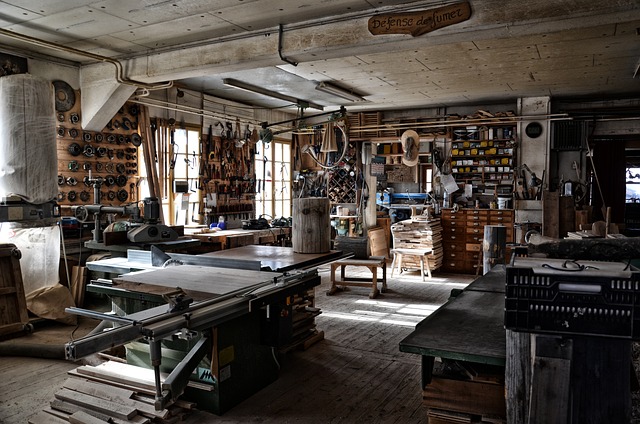A skilled carpenter's precise trim installation is essential for achieving a visually stunning and structurally sound home renovation. Their expert craftsmanship ensures seamless integration of custom trim pieces, enhancing both the appearance and durability of the space. This involves carefully measuring, cutting, and fitting trim against walls, accounting for any irregularities, and utilizing specialized tools like squares, levels, laser measurers, miter saws, and nail guns. The carpenter's attention to detail and technical precision is critical for maintaining straight lines, consistent gaps, and flawless joints, resulting in a high-quality finish that elevates the overall design of the renovation project.
When revamping or building a home, the subtle yet impactful details can elevate the entire aesthetic. Among these, custom trim fits are pivotal in achieving that polished, finished look. This article delves into the artistry of carpentry, focusing on the precision required for trim to sit flawlessly against walls. We’ll explore how skilled carpenters assess and adapt to wall variations, employing specialized tools and techniques to ensure a seamless fit every time. From understanding the importance of miter cuts to mastering the nuances of baseboard and crown molding installation, this guide provides essential tips for achieving flawless trim fitting. Carpenters are the craftsmen behind these meticulous details, ensuring long-term stability and a refined finish. Join us as we navigate through best practices, address common issues, and reveal how expert carpenters tackle even the most challenging spaces.
- Understanding Custom Fits for Trim in Home Renovations
- The Role of a Skilled Carpenter in Achieving Precision Fits
- Assessing Wall Variations and Materials Before Installation
- Tools and Techniques Carpenters Use for Perfect Trim Fitting
Understanding Custom Fits for Trim in Home Renovations

When engaging in home renovations, achieving a seamless finish often hinges on the precision of custom fits for trim. A skilled carpenter plays a pivotal role in this process by meticulously measuring and crafting trim pieces that fit snugly against walls and other surfaces. The importance of tailor-made trim cannot be overstated, as it contributes to the overall aesthetic appeal and functional integrity of the space. Custom fits ensure that corners are neatly joined, angles are precisely cut, and transitions between different materials are invisible, creating a cohesive and polished look. This level of customization is particularly beneficial in areas with complex geometry or where walls may not be perfectly straight. By investing in the expertise of a carpenter who specializes in bespoke trim work, homeowners can elevate the quality and character of their renovation project. The attention to detail and personalized service provided by such professionals often result in a superior end product that stands out for its elegance and craftsmanship. In the realm of home improvement, custom-fitted trim is a testament to the enduring value of skilled labor and the fine touch of an artisan’s hand.
The Role of a Skilled Carpenter in Achieving Precision Fits

When it comes to achieving precision fits for trim against walls, the expertise of a skilled carpenter cannot be overstated. A carpenter’s proficiency in measuring, cutting, and fitting wood with precision is paramount to ensuring that every piece of trim aligns flawlessly with its intended surface. Their understanding of the material’s properties allows them to select the appropriate tools and techniques to yield the desired results without causing damage to the walls or compromising the integrity of the trim.
The attention to detail that a seasoned carpenter brings to the job is unparalleled. They meticulously assess each wall’s contours, taking into account any irregularities or peculiarities that might affect the fit of the trim. This level of scrutiny is essential for custom fits, as it ensures that the trim not only looks aesthetically pleasing but also functions correctly within the space. A carpenter’s craftsmanship transforms raw materials into harmonious components of the overall design, creating a seamless transition between different elements of the room’s interior. Their role is not just to install trim; it is to sculpt it into place with an artisan’s touch, ensuring that every joint and corner is as perfect as can be.
Assessing Wall Variations and Materials Before Installation

When a carpenter approaches a project that involves trim work, accurately assessing the variations in wall surfaces and the materials used is paramount for achieving a perfect fit. Walls are not uniform; they can have irregularities such as out-of-plane deviations, bulges, or dips that result from settlement, structural adjustments, or initial construction practices. A skilled carpenter will carefully measure and inspect the walls to identify these variations, ensuring that the trim will adhere snugly against the wall without gaps or visible misalignments. This meticulous process often involves using tools like a framing square, level, or laser distance measurer to detect even the slightest deviations from a true plane.
Furthermore, understanding the composition of the walls is equally important. Different materials, such as drywall, plaster, brick, or wood, each present their unique challenges and require distinct approaches for trim installation. For instance, while drywall might yield slightly under pressure, hard materials like brick may require additional fastening methods to secure the trim. A carpenter must select appropriate fasteners, adhesives, or other fixing solutions tailored to the wall’s material to ensure a solid and lasting bond. By combining their knowledge of wall variations with an understanding of the underlying materials, carpenters can skillfully craft trim that complements the architecture, enhances the aesthetic appeal, and endures over time.
Tools and Techniques Carpenters Use for Perfect Trim Fitting

Experienced carpenters understand that achieving a flawless fit for trim against walls is both an art and a science. To ensure precision, they employ a variety of tools and techniques that blend skill with meticulous measurement. A key tool in their arsenal is the framing square, which allows for precise angle measurements at the corners where trim meets wall or adjoining trim. Carpenters also rely on the trusty tape measure to take accurate length measurements, ensuring each piece of trim is cut to size before installation. The use of a miter saw or power miter saw is essential for cutting the ends of trim at the desired angle, whether it’s a 45-degree cut for corners or a bevel cut for trim around doors and windows. For more complex fitting situations, carpenters may use spacers to hold the trim in place until it is properly adhered, ensuring that it aligns perfectly with adjacent surfaces. Shims are another valuable tool, allowing carpenters to fine-tune the fit of the trim against walls that may not be perfectly flat or plumb. Once the trim is cut and in position, a nail gun can quickly secure it without compromising the finish. Throughout the process, carpenters continuously check their work with a level to guarantee straight lines and even gaps between trim pieces and the wall. This combination of tools and techniques, when applied by a skilled carpenter, results in a seamless and aesthetically pleasing trim installation that enhances the overall appearance of the room or structure.
In conclusion, integrating custom-fit trim into home renovations is a testament to the craftsmanship and precision that skilled carpenters bring to every project. By meticulously assessing wall variations and materials, employing specialized tools and techniques, and understanding the nuances of custom fits, these professionals ensure that each piece of trim aligns flawlessly with its surroundings. Homeowners looking for a seamless and aesthetically pleasing result in their renovations will find that the investment in a carpenter’s expertise is well worth the outcome. A perfectly fitted trim not only enhances the visual appeal but also stands as a symbol of quality and attention to detail, making it an indispensable component of any home refurbishment endeavor.
